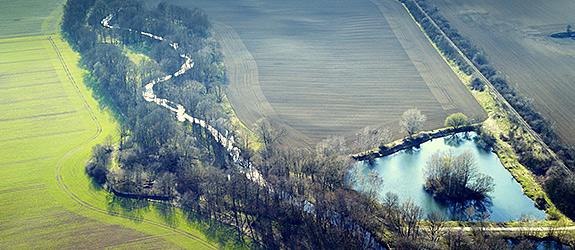
INTEGRATED PROJECT (IP)
Water and matter flux dynamics in catchments
Relevance and background
Freshwater is a crucial, life-sustaining resource for mankind, and a good status of freshwater quantity and quality are major prerequisites for prosperity, health and welfare of any civilisation. Human activities within the terrestrial environment have severe impacts on water and matter fluxes not only at local, but often at regional or even global scales affecting water quantity and quality as well as related ecosystem services. Furthermore climate change projections predict significant changes to the water balance components within the next decades across all spatial and temporal scales, but with considerable uncertainty regarding the magnitude, and in some cases even the direction of the trend. For a long-term, sustainable management of our terrestrial environment and for securing the provision of water, energy and food we need a mechanistic understanding of anthropogenically and naturally induced changes to the system. In order to predicts future states of our water resources, a quantitative assessment of water, matter and energy fluxes within the environment will be of upmost importance. Finally, we will also need to prepare for significant changes in the scientific, political, and economical boundary conditions in Germany, Europe, and the world. This requires tools that allow reliable and useful observations and robust predictions over long time scales, upt o regional spatial scales as well as for a variety of different catchments in order to be able to advise adequate management activities. This IP produces significant contributions to improve those quantitative predictions.
Scientific challenges
Solute fluxes in catchments and landscapes are the integral result of a multitude of hydrological, biogeochemical and ecological processes operating at small scales. It is utterly impossible to resolve these processes in all detail at larger scales and to describe water and matter fluxes purely based on first principles. However, structural characteristics of catchments at hierarchical scales distinctly define how water and matter are mobilised, transported and transformed. Therefore, we need to develop methodologies to identify the relevant structural organisation of catchments that dominantly controls catchment water and matter dynamics. A crucial question is what detail is ultimately needed for a robust prediction of fluxes. A major research challenge in this context is to find robust, transferable functional and structural indicators and relationships, which could lead to an applicable concept for linking structure and function (e. g. to describe mobilisation, transformation, transport).
Current research, though, is too often focused on single catchments and their peculiar behaviour. Alternatively, new, general catchment classifications with respect to their matter flux and turnover dynamics need to be developed. Based on such a classification, quantitative descriptions of adequate complexity (ranging from simple algebraic equations and relationships to highly complex numerical models) can be derived to predict catchment matter fluxes across scales. Such descriptions will allow improving matter flux predictions for large catchments. This could lead to a toolbox of models that are solidly grounded in a consistent mechanistic understanding of how large scale behaviour emerges from small scale processes.
The need for transferability of these descriptions/models across different climate zones, regions and catchments poses another great challenge. Addressing this challenge calls for robust model parameterisation and regionalisation schemes, which are coherent across spatial and temporal scales and applicable in different catchments for different conditions. Differences in scaling behaviour of terrestrial and riverine transport and transformation processes need to be understood to link processes across scales. The models also need to be able to operate in areas with limited data availability and to make reasonably accurate predictions outside the calibration range, if they are to be used to assess the effect of global change (e. g. climate warming, land use change).
To successfully address these scientific challenges requires coherent data bases across different catchments based on new high resolution (in space and time), as well as integrative measurements of state variables for model/concept development and validation. Such data can be obtained from new, "intelligent" monitoring strategies for water quality variables and water-matter flux relationships, which should be closely linked to model development. This also entails a continuing, adaptive development of already existin (e. g. TERENO) as well as new observatories to specifically address integrative research questions.
